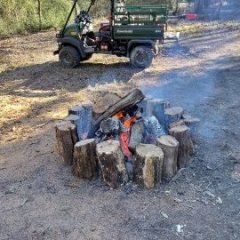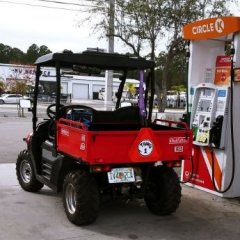Leaderboard
Popular Content
Showing content with the highest reputation on 02/05/2021 in all areas
-
Hello all, In looking for a synthetic line for my Outfitter 400's 3500 lb. Runva winch I ran across this offering from Harbor Freight; $30.99 with 20% off coupon + tax = $26.40--not too bad (please spare me the "Cheap Chinese junk" yowls, where do you think 99.44% of the components of, and stuff we buy, for our toys comes from?). It is made of UHMW polyester with a claimed (and fully believable) tensile strength of 4700 lbs. and a working load of 3000 lbs.--which is in keeping with the specs published by most manufacturers of UHMW rope and therefore much more believable than the 6000 and absurd 8200 lb. claims made by other vendors. It comes with a G70 snap-hook (sized for 1/4" chain), and an anodized aluminum Hawes type fairlead. The package I bought did not contain the red strap shown in HF's ad, which based on reviews is a common failing of the kit. Also, there is no snubber provided, I got a nice one of silicone rubber with stainless fasteners from Amazon for $7. The winch and business ends of the rope are sleeved with black urethane coated nylon (were i to guess) protective sleeves-for 8+ ft at the winch end and 5 ft. or so at he hook end. The winch end has a couple inches of heat shrink tubing to prevent unravelling and assist in fastening it to the typical bore-through/set screw winch drum. The 12-strand braided rope appears to be of a high quality UHMW polyester, as claimed, the fairlead is cleanly cast and appears to have been glass bead or shot blasted after casting a it has a smooth fine pebble grain finish. The mounting holes are at the standard 124 mm (4-7/8") center-to-center distance as is common on ATV and UTV winches. All 50' installed easily on my winch, the 8 ft or so of protective sleeve providing a nice supporting first wrap. The sleeve at the business end completely covers the last layer of rope, providing a nice shield to protect the synthetic rope from prolonged UV exposure. Likewise, the fairlead bolted right up with no problem. on the drum: the Hawes fairlead and snubber: long shot: It is important to keep in mind when using synthetic winch rope that, while it is very strong, it is also very low stretch, typically just 3.5% at break--in practice this can result in dynamic shock loading exceeding it's tensile strength. This is also true of steel wire rope, but the metallic rope can better handle dynamic loading. I also would not recommend synthetic rope for use in that torture track that is common to winch hoisted low-cost ATV/UTV snowplows. The mechanical dis-advantage which most plow designs operate and apply to the winch hoist is staggering. In such plows am less surprised that the rope (synthetic or wire) breaks than that it survives more than one use. I like it... [update 02/04/2021] After some experimentation using a digital scale, a 55 lb. anvil and both the roller and Hawes fairleads I have re-installed the roller fairlead. I found that at extreme fleet angles (45° to 90°--angles you should try to avoid) the Hawes fairlead increased required cable load by 10% to 25% vs. the roller fairlead. One caution however; make certain there is sufficient overlap of the roller faces and the ends of their companion rollers--both ways. On my roller fairlead the rollers overlap the ends of their 90° opposed companion by 1/2 their diameter as illustrated below: roller orientation, my fairlead--top view: roller orientation, my fairlead--side view: I have seen roller guides in which this was not the case which allows the much more flexible synthetic line to "fall off" the active roller and jam between the end of its companion roller and the fairlead frame--which would of course be bad. While I had it apart I also stitched and whipped the protective sleeve to the rope at both the lead end of the trailing length into the winch, and the trailing end aft of the hook. winch end: hook end: anchor point on the drum: sleeved rope in fairlead: [/update]1 point
-
They don't. Sorry, but as I said, I have no idea exactly how much it should be. But on my Honda civic, it seems like it wasn't a lot. I don't think a healthy mule starter would pull 60 amps though. That was my point about it might be too low for 60a. tester. But the 3amp, is more about it being useful for automotive needs. And there's not really any trade off on the higher end, for use around the house. So there's no reason not to. As long as it's one of these same knockoff Chinese junk. It'll be affordable. That capability in a major brand would be plenty expensive.1 point
-
1 point
-
If you bought an MSU 500, you will soon see ITS NOT WORTH IT ... Ihave had problems since the 1st day I bought it new. at Tractor Supply .. and Massimo has refused to pay one dime of repairs .. its been in the only repair shop in my state that will still even work on Massimo, 6 times .. and only if you pay cash..1 point
This leaderboard is set to New York/GMT-04:00



